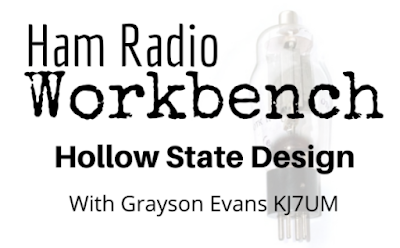Podcasting since 2005! Listen to Latest SolderSmoke
Sunday, August 15, 2021
Sam KD2ENL's Homebrew Integrated Circuit Chips
Saturday, August 14, 2021
KI7NNS's "Pacific 40" Simple SSB Transceiver
Congratulations to Kacy KI7NNS for a really nice rig.
Thursday, August 12, 2021
Grayson Evans KJ7UM on the Ham Radio Workbench Podcast
Wednesday, August 11, 2021
More Info on Tom's Amazing Junkbox 20 meter Receiver (using FPGAs)
Tom also sent me Firmware sourcecode that may be reusable for STM8 users, and the FPGA design file (for Quartus users). If anyone has a GitHub or similar site that can host these files, please let me know and we will send them to you.
Tuesday, August 10, 2021
Mythbuster Video #16 -- GLOWING NUMERALS! In Juliano Blue!
I added two San Jian frequency counters to the front panel. In addition to making the rig a lot easier to operate, they add a classy touch of Juliano Blue to the project.
I got my counters here: https://www.ebay.com/itm/224223678132
There is a limitation of some of the the San Jian counters: https://soldersmoke.blogspot.com/2021/02/a-problem-with-san-jian-plj6-led-counter.html
But this limitation didn't cause any problem with this rig: In this case I just plugged in the IF frequency of 5.2397 MHz. I connected the input to my VFO running around 9 MHz. For 20 meter signals, I select the "up" option; the San JIan counter just adds the IF frequency to the VFO Frequency. For example 9 + 5.2397 = 14.2397 MHz . For 75, I select the "down" option. Here the San Jian just subtracts the IF frequency from the VFO frequency -- for example 9 - 5.2397 = 3.7603 MHz.
The band select switch operates relays that select the proper band-pass and low-pass filters. This switch also alternatively turns on either the 20 meter San Jian or the 75 meter San Jian.
Monday, August 9, 2021
Mythbuster Video #15 The Mythbuster Signal As Seen in the NA5B WebSDR
Sunday, August 8, 2021
Mythbuster Video #14 -- ON THE AIR!
On August 5 I put the Mythbuster on the air, making QSOs on both 75 and 20 meters. This video is from the following day -- I was on 75 meters. My first QSO with this rig was on 20 with S57DX. That was a good omen. TRGHS
I had no feedback or spur problems with the BITX40 module amplifier circuit. And I didn't release any IRF510 smoke. There is, of course, a lot more output on 75 than on 20. That's just the nature of the IRF510. I get about 4 watts out on 20 and about 9 watts out on 75 (with a 12 volt supply). At Pete's suggestion I might replace the IRF510 with a Mitsubishi RD06HHF1.
I had a couple of minor problems getting the transmitter going. I will describe these in a future video.


































